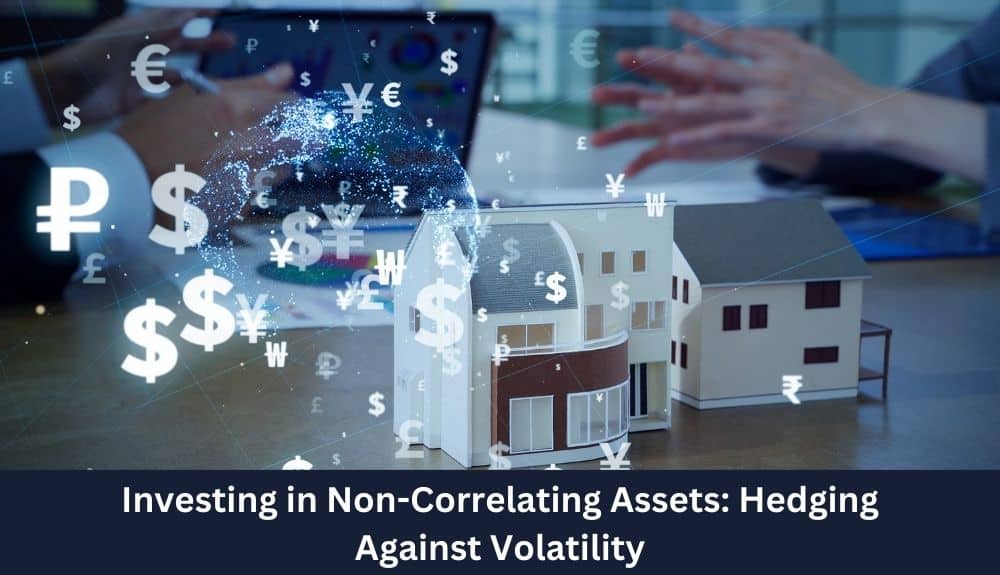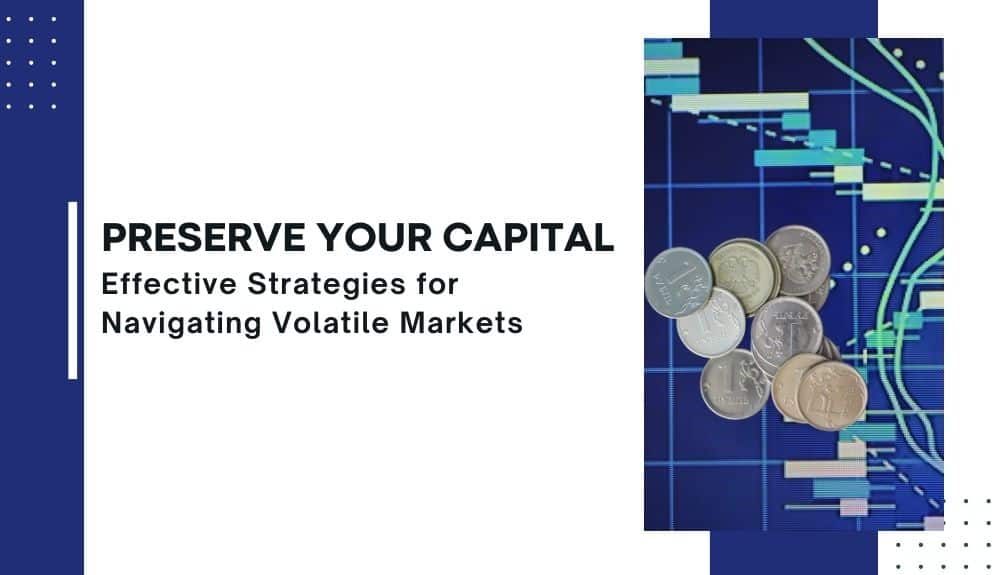In today’s unpredictable financial landscape, navigating volatile markets can be a daunting task. Picture this: you’ve diligently built your investment portfolio, only to see its value fluctuate wildly due to market instabilities. How do you safeguard your hard-earned capital and weather the storm when market conditions take a turn for the worse?
When market volatility strikes, having effective strategies in place becomes paramount. From minimizing risks to preserving capital, these strategies are the lifeline that can help you maintain financial stability when uncertainty looms large. But what exactly are these strategies, and how can they shield your investments from the impacts of volatile market conditions?
In this blog, we delve into proven methods to protect your investments during times of market turmoil. Discover how to diversify your portfolio, leverage non-correlating assets, and implement risk-management techniques like options and stop-loss orders to fortify your financial standing. Explore insights on working with financial advisors, understanding asset allocation, and establishing a solid portfolio protection strategy that aligns with your risk tolerance, ensuring long-term stability.
Introduction to Preserving Capital in Volatile Markets
Investing in volatile markets can be a challenging endeavor, with fluctuating stock prices and unpredictable market conditions. It becomes crucial to implement strategies that not only minimize risk but also protect your investments and preserve capital for long-term financial stability.
During market downturns or periods of heightened volatility, maintaining the value of your investment portfolio becomes paramount. It is essential to navigate these turbulent times with caution and make informed decisions that align with your financial goals and risk tolerance.
In this section, we will explore effective strategies to preserve your capital in volatile markets. These strategies will help you manage risk, mitigate potential losses, and maintain financial stability amidst uncertain market conditions. By implementing these proven techniques, you can safeguard your investments and weather the storms of market volatility.
The strategies we will discuss include portfolio rebalancing, diversification, investing in non-correlating assets, dividend stocks, adopting a long-term perspective, avoiding impulse decisions driven by emotions, using risk management techniques like stop-loss orders and options, and seeking professional guidance from a financial advisor.
Now, let’s dive into each strategy in detail and discover how they can protect your investments in volatile markets.
Portfolio Rebalance: Maintaining Optimal Asset Allocation
To navigate through volatile markets and protect your investments, maintaining an optimal asset allocation is crucial. Regularly rebalancing your portfolio plays a significant role in managing risk and preserving capital. By periodically adjusting the allocation of your investments, you can ensure that your portfolio aligns with your financial goals and risk tolerance.
The Importance of Rebalancing
Over time, the performance of different asset classes can vary, which may lead to an imbalance in your portfolio. For example, if the stock market experiences a significant upswing, the value of your stock investments may increase disproportionately compared to other asset classes such as bonds or cash. This imbalance can expose your portfolio to higher levels of risk.
How Rebalancing Works
Rebalancing involves analyzing your portfolio’s current allocation and making adjustments to bring it back in line with your target allocation. This process typically involves selling some of the investments that have increased in value and using the proceeds to purchase investments that have underperformed. By doing so, you are essentially “selling high” and “buying low,” ensuring that your portfolio remains diversified and aligned with your long-term investment strategy.
Reaping the Benefits
Regular portfolio rebalancing offers several benefits in volatile markets. Firstly, it helps to control risk by preventing any single asset class from dominating your portfolio. By diversifying your investments across different asset classes, you can mitigate the impact of market downturns on your overall portfolio. Secondly, rebalancing allows you to take advantage of buying opportunities. When certain asset classes are undervalued, rebalancing enables you to reallocate funds and invest in those assets, potentially enhancing your returns.
Monitoring Frequency and Thresholds
The frequency of portfolio rebalancing depends on your individual circumstances and preferences. While some experts recommend rebalancing annually or semi-annually, others suggest more frequent monitoring, especially during volatile times. Establishing thresholds for rebalancing also helps guide your decision-making. For instance, if your target allocation is 60% stocks and the current allocation exceeds 65% due to market fluctuations, it might be time to rebalance.
In conclusion, regularly rebalancing your portfolio is essential for managing risk and preserving capital in volatile markets. By ensuring your investments align with your target asset allocation, you can navigate uncertain market conditions and maintain a well-diversified portfolio. Stay proactive and review your portfolio regularly to make informed decisions that align with your long-term financial goals.
Diversification: Spreading Risk Across Multiple Assets
Diversification is a crucial strategy for investors looking to protect their capital in volatile markets. By spreading risk across multiple asset classes, investors can reduce their exposure to any one specific investment and minimize the impact of market fluctuations. Let’s explore the concept of diversification and its role in reducing risk in volatile markets.
The Importance of Diversification
Diversification is the practice of investing in a variety of assets that have different risk and return characteristics. The goal is to create a portfolio that is not overly reliant on any single investment or asset class. When one investment is performing poorly, others may be performing well, helping to offset losses and provide stability to your overall portfolio.
Reducing Risk in Volatile Markets
In volatile markets, the value of individual stocks or sectors can fluctuate significantly. By diversifying your portfolio, you can minimize the impact of these fluctuations on your overall investment. For example, if you have a portfolio that consists solely of technology stocks and the tech sector experiences a sharp decline, your entire portfolio would suffer. However, if you had a diversified portfolio that included stocks from various industries such as healthcare, consumer goods, and energy, the negative impact would be mitigated by the positive performance of other sectors.
Examples of Different Asset Classes
There are various asset classes that investors can consider when diversifying their portfolio. Some common examples include:
1. Stocks: Investing in a mix of large-cap, mid-cap, and small-cap stocks across different sectors and industries can provide diversification within the equity asset class.
2. Bonds: Including a range of government, corporate, and municipal bonds can help balance the risk of your portfolio and offer more stable returns.
3. Real Estate: Adding real estate investments, such as income-generating properties or real estate investment trusts (REITs), can provide diversification beyond traditional stocks and bonds.
4. Commodities: Investing in commodities like gold, silver, or agricultural products can offer protection against inflation and currency fluctuations.
5. Alternative Investments: Consider diversifying into alternative investments like private equity or hedge funds, which may have a lower correlation to the broader stock market.
Remember, the key to effective diversification is selecting assets that have low or negative correlation to each other. This means their values don’t move in sync, providing greater potential for stable returns even in volatile markets.
Conclusion
Diversification is an essential strategy for protecting your investments in volatile markets. By spreading your risk across multiple asset classes, you can reduce the impact of market fluctuations and preserve your capital. Remember to regularly review and rebalance your portfolio to ensure it aligns with your risk tolerance and long-term financial goals. By embracing diversification, you can navigate uncertain times with confidence and maintain stability in your investment journey.
Investing in Non-Correlating Assets: Hedging Against Volatility

In uncertain and volatile markets, it is crucial to explore investment options that have low or negative correlation to the stock market. By diversifying your portfolio with non-correlating assets, you can mitigate risk and protect your capital from market fluctuations. Let’s delve into the benefits of investing in real estate, bonds, and alternative investments.
Real Estate: Stability in Tangible Assets
Investing in real estate provides several advantages during times of market volatility. Real estate values tend to be less impacted by short-term market movements, offering stability in the face of volatility. Properties like residential homes, commercial buildings, and rental properties can generate steady income streams, making them reliable long-term investments. Real estate also serves as an excellent hedge against inflation, as rental prices and property values tend to increase over time.
Bonds: Fixed Income and Capital Preservation
Bonds are debt instruments issued by governments and corporations. They offer a fixed income stream and are known for their stable returns. During periods of market volatility, bonds become an attractive investment option as they provide regular interest payments and the return of principal upon maturity. Government bonds, corporate bonds, and municipal bonds are often considered safer assets and can act as a cushion to protect your capital preservation during uncertain times.
Alternative Investments: Thinking Outside the Box
Alternative investments encompass a broad range of assets that go beyond traditional stocks and bonds. These investments include commodities, precious metals, hedge funds, private equity, and real estate investment trusts (REITs). Alternative investments often have low or negative correlation to the stock market, providing diversification and potential returns not tied to traditional market movements. However, it’s essential to thoroughly research and understand the risks associated with each alternative investment before adding them to your portfolio.
As you explore investing in non-correlating assets, keep in mind that each asset class carries its own set of risks and rewards. Diversification is key to spreading risk and protecting your capital. A well-diversified portfolio with a mix of real estate, bonds, and alternative investments can help stabilize your investment performance during turbulent times.
Remember to consult with a financial advisor to ensure these investments align with your risk tolerance, financial goals, and time horizon. They can provide guidance on asset allocation and help you develop a solid portfolio protection strategy that suits your unique circumstances.
In conclusion, investing in non-correlating assets is an effective strategy for hedging against volatility. By diversifying your portfolio with real estate, bonds, and alternative investments, you can safeguard your capital and navigate through uncertain market conditions with confidence.
Dividend Stocks: Generating Income and Protecting Capital
Investing in dividend stocks can be a smart strategy to generate a steady income stream and protect your capital in volatile markets. Dividend-paying companies distribute a portion of their profits to shareholders in the form of regular dividend payments. These dividends can provide a reliable source of income regardless of market conditions. Here’s how dividend stocks can help you generate income and safeguard your capital:
Steady Income Stream
Dividend stocks offer investors the opportunity to earn a consistent income stream. While stock prices may fluctuate in volatile markets, dividends provide a stable source of cash flow. By investing in companies with a track record of paying reliable dividends, you can create a steady income stream to meet your financial needs. Dividend payments can be especially valuable during market downturns when other sources of income may be unreliable.
Defensive Strategy
Investing in dividend-paying stocks also acts as a defensive strategy in volatile markets. Dividend stocks tend to be more resilient during market downturns compared to non-dividend-paying stocks. Companies that consistently pay dividends often have stable cash flows and solid financial fundamentals, which can help them weather market turbulence. Even if the stock price declines, you can still benefit from the regular dividend payments, which can help offset any potential losses.
Dividend Reinvestment
Another advantage of dividend stocks is the option to reinvest dividends. Many companies offer dividend reinvestment programs (DRIPs) that allow shareholders to automatically reinvest their dividends to purchase additional shares. This can help amplify your returns over time through the power of compounding. By reinvesting dividends, you can acquire more shares, potentially increasing your future dividend income and long-term capital growth.
Dividend Growth
Investing in dividend stocks can also provide the opportunity for dividend growth. Some companies consistently raise their dividends over time as they experience growth and profitability. By investing in these dividend growth stocks, you not only benefit from the initial dividend income but also enjoy the potential for increasing dividends in the future. This can enhance your income and provide further protection for your capital in volatile markets.
Conclusion
In uncertain and volatile markets, investing in dividend-paying stocks can be a prudent strategy. By generating a steady income stream and acting as a defensive asset, dividend stocks offer a way to protect your capital and maintain financial stability. Consider including dividend stocks in your portfolio to safeguard your investments and potentially benefit from their long-term growth potential.
Remember to conduct thorough research and carefully analyze individual companies before investing in dividend stocks. Financial advisors can provide valuable guidance and help you identify dividend-paying stocks that align with your investment objectives and risk tolerance.
Long-Term Perspective: Overcoming Short-Term Volatility
In today’s fast-paced financial markets, it’s easy to get caught up in short-term fluctuations and panic when prices dip. However, maintaining a long-term perspective is crucial for overcoming short-term volatility and preserving your capital. Here are a few key reasons why taking a long-term approach is essential:
1. Avoid Knee-jerk Reactions
Reacting impulsively to short-term market movements can lead to poor investment decisions. It’s important to remember that market downturns are often temporary, and knee-jerk reactions can result in selling investments at a loss or missing out on potential gains. By maintaining a long-term perspective, you can weather the storm and stay focused on your financial goals.
2. Time to Ride Out Volatility
One of the advantages of a long-term approach is the ability to ride out market volatility. Over time, markets tend to recover and trend upwards, even after periods of decline. By staying invested and giving your investments time to grow, you increase your chances of achieving positive returns and meeting your long-term financial objectives.
3. Capitalize on Compounding Returns
Long-term investing allows you to take advantage of compounding returns. Compounding occurs when your investment gains generate additional earnings, and those earnings are reinvested. Over time, this compounding effect can significantly boost your overall investment returns. By staying focused on the long term, you can harness the power of compounding and maximize the growth of your capital.
4. Capture Market Upswings
Short-term market volatility often comes with periods of market upswings. By maintaining a long-term perspective, you can position yourself to capture these positive market movements. Trying to time the market and jump in and out based on short-term fluctuations is a risky strategy that rarely pays off. Instead, staying invested over the long term allows you to benefit from the overall growth of the market.
5. Stay True to Your Investment Strategy
Taking a long-term perspective helps you stay true to your investment strategy. It allows you to stick to a well-thought-out plan and avoid being swayed by short-term market noise or rumors. By focusing on your long-term goals and the fundamentals of your investments, you can make more informed decisions and minimize the impact of short-term market volatility.
In conclusion, maintaining a long-term perspective is crucial for overcoming short-term volatility in the financial markets. By avoiding knee-jerk reactions, capitalizing on compounding returns, capturing market upswings, and staying true to your investment strategy, you can navigate market fluctuations with confidence. Remember, investing is a marathon, not a sprint, and taking a long-term approach is key to preserving your capital and achieving long-term financial stability.
Avoid Impulse Decisions: Emotional Stability in Volatile Markets
Investing in volatile markets can be emotionally challenging, as market fluctuations can trigger fear, panic, and impulsive decision-making. However, succumbing to these emotions can often lead to poor investment choices and significant losses. To protect your capital and navigate volatile markets successfully, it is crucial to maintain emotional stability and make rational decisions. Here are some essential tips to help you stay level-headed during market volatility:
1. Focus on Long-Term Goals
Keep your long-term financial goals in mind and remind yourself that short-term market fluctuations are part of the investing journey. By maintaining a long-term perspective, you are better equipped to ride out temporary market downturns and capture potential long-term gains. Remember that successful investing requires patience and discipline.
2. Avoid Overreacting to News Headlines
News headlines can be sensationalized and often create a sense of urgency. It is important not to overreact to every piece of news or market commentary. Instead, focus on high-quality, reliable sources of information and seek a balanced understanding of the market conditions. Engage in thorough research and consider multiple perspectives before making any investment decisions.
3. Establish a Well-Diversified Portfolio
A well-diversified portfolio can help mitigate risks associated with volatile markets. Allocate your investments across different asset classes, industries, and geographic regions to spread risk and reduce the impact of any single investment’s performance on your overall portfolio. Diversification can provide a buffer against market volatility and protect your capital during uncertain times.
4. Stick to Your Investment Plan
Developing a solid investment plan aligned with your risk tolerance and long-term goals is crucial for staying on track during market volatility. Stick to your plan even when emotions tempt you to deviate. Avoid making impulsive changes to your investment strategy based on short-term market movements. Remember, successful investing relies on consistency and discipline.
5. Consult with a Financial Advisor
A qualified financial advisor can provide valuable guidance and support during volatile market conditions. They can help you assess your risk tolerance, develop an appropriate investment strategy, and offer objective advice to prevent emotional decision-making. A financial advisor can also provide reassurance and help you stay focused on your long-term financial objectives.
6. Practice Self-Control and Discipline
Emotional stability in volatile markets requires self-control and discipline. Avoid knee-jerk reactions to market fluctuations and resist the urge to chase quick profits or sell investments out of fear. Stick to well-thought-out strategies and remember that making decisions based on emotions can lead to costly mistakes.
7. Stay Informed and Educated
Continuously educate yourself about investing principles, market dynamics, and economic trends. The more knowledgeable you are, the better equipped you will be to make informed decisions based on facts and analysis rather than emotions. Stay updated with financial news, attend seminars, read reputable publications, and engage in discussions with experts in the field.
By following these tips, you can cultivate emotional stability and make sound investment decisions even during times of market volatility. Remember, preserving your capital and achieving long-term financial stability requires patience, discipline, and a rational mindset. Stay focused on your goals, diversify your portfolio, and seek professional guidance when needed.
Risk Management Techniques: Stop Loss Orders and Options
In volatile markets, it’s essential to employ effective risk management techniques to protect your capital. Two popular strategies for mitigating risk are stop loss orders and options. These tools can help minimize losses and provide a level of security during market downturns.
Stop Loss Orders
A stop loss order is a predetermined instruction given to your broker to sell a stock or other asset when it reaches a specified price. This order type is designed to limit potential losses by automatically triggering a sale when the asset’s price falls below a certain threshold.
Stop loss orders act as a safety net, ensuring that you exit a position before further losses occur. By setting a stop loss order, you are taking a proactive step to protect your capital if the market moves against you. This strategy can be particularly useful in highly volatile markets where price fluctuations are more pronounced.
Options
Options provide another avenue for risk management in volatile markets. An option is a financial derivative that gives the holder the right, but not the obligation, to buy or sell an asset at a predetermined price within a specified period.
One way to use options as a risk management tool is through protective puts. A protective put involves buying a put option on an underlying asset in your portfolio. If the market experiences a downturn, the put option increases in value, offsetting potential losses in the stock or other asset.
Another strategy is to sell covered call options. This involves writing call options on assets in your portfolio that you already own. By doing so, you collect premiums from the buyer of the call option. If the market remains stable or experiences a slight decline, you keep the premium and retain ownership of the asset. However, if the market rises significantly, the call option may be exercised, and you sell the asset at the predetermined price.
Benefits of Risk Management Techniques
Implementing stop loss orders and options as risk management techniques can offer several benefits. First and foremost, these strategies provide a sense of control and reduce the impact of emotional decision-making during volatile times. By setting objective criteria for exiting a position or hedging risk, you avoid making impulsive decisions based on fear or greed.
Moreover, stop loss orders and options help limit losses and protect your capital. This is especially crucial for long-term investors who aim to preserve their financial stability and maintain a disciplined investment approach. By utilizing these risk management techniques, you have a layer of protection against sudden market fluctuations and unpredictable events.
In conclusion, stop loss orders and options are valuable risk management tools in volatile markets. They provide a structured approach to limit losses, protect your capital, and maintain financial stability. Consider incorporating these techniques into your investment strategy to navigate market volatility with confidence.
Working with a Financial Advisor: Professional Guidance in Turbulent Times

Seeking professional advice from a financial advisor can be instrumental in successfully navigating volatile markets and developing a robust portfolio protection strategy. When faced with unpredictable market conditions, the expertise and guidance of a financial advisor can help investors make informed decisions and preserve their capital. Here are some key benefits of working with a financial advisor during turbulent times:
Objective Perspective and Expertise
A financial advisor brings an objective perspective to the table, free from emotional biases that can cloud investors’ judgment during market volatility. Their expertise and knowledge of market trends, risk management techniques, and investment strategies allow them to provide valuable insights tailored to each individual’s financial goals and risk tolerance.
Personalized Investment Planning
One of the primary advantages of partnering with a financial advisor is the creation of a personalized investment plan. They assess your financial situation, goals, and risk tolerance to develop a comprehensive strategy that aligns with your specific needs. This plan takes into account factors such as asset allocation, diversification, and risk management techniques, aiming to protect your investments while maximizing potential returns.
Access to a Network of Resources
Financial advisors often have access to a wide range of resources, including research reports, market analysis, and advanced portfolio management tools. These resources enable them to stay updated on market trends and identify opportunities even in turbulent times. By leveraging their network, financial advisors can also provide access to alternative investment options, such as hedge funds or private equity, which can further enhance your portfolio’s diversification.
Ongoing Monitoring and Adjustment
During volatile market conditions, it becomes crucial to monitor investments closely and make adjustments when necessary. Financial advisors regularly review your portfolio to ensure it remains aligned with your financial goals and risk tolerance. They can make strategic adjustments, rebalancing your portfolio to maintain an optimal asset allocation and mitigate risk. This ongoing monitoring helps protect your capital and adapt to changing market conditions.
Emotional Support and Discipline
Emotional stability is essential while investing in turbulent markets. Financial advisors act as a calming influence, providing guidance and reminding investors of their long-term goals. They help instill discipline and discourage impulsive decisions driven by short-term market movements. By promoting a long-term perspective, financial advisors reinforce the importance of staying focused on the bigger picture and not being swayed by market fluctuations.
In conclusion, seeking professional guidance from a financial advisor has numerous benefits during volatile market conditions. They can offer an objective perspective, create personalized investment plans, provide access to resources, monitor and adjust your portfolio, and offer emotional support. By working with a financial advisor, investors can navigate turbulent times with confidence, protect their capital, and achieve long-term financial stability.
Conclusion: Strategies for Protecting Your Investments in Volatile Markets
In today’s uncertain financial landscape, safeguarding your investments in volatile markets is imperative for long-term financial stability. By implementing a range of strategies, you can minimize risk and ensure that your capital is preserved. Let’s recap the key strategies discussed throughout this article:
1. Portfolio Rebalance: Maintaining Optimal Asset Allocation – Regularly reevaluating and rebalancing your portfolio allows you to manage risk effectively. This involves adjusting the proportions of different asset classes to align with your investment goals and risk tolerance.
2. Diversification: Spreading Risk Across Multiple Assets – Diversifying your portfolio by investing in different asset classes, such as stocks, bonds, real estate, and alternative investments, can help mitigate the impact of market volatility. This strategy ensures that you’re not overly exposed to any single investment.
3. Investing in Non-Correlating Assets: Hedging Against Volatility – Consider allocating a portion of your investments to assets with low or negative correlation to the stock market. These investments, such as real estate or bonds, can act as a hedge against market fluctuations and provide stability to your portfolio.
4. Dividend Stocks: Generating Income and Protecting Capital – Including dividend-paying stocks in your investment portfolio can provide a steady income stream, especially during market downturns. Dividends act as a defensive strategy, offering a source of returns even when stock prices are volatile.
5. Maintaining a Long-Term Perspective – It’s crucial to resist the temptation to react to short-term market fluctuations. Instead, maintain a long-term investment approach and focus on the underlying fundamentals of your investments. This perspective allows you to weather short-term volatility and capitalize on long-term growth opportunities.
6. Avoid Impulse Decisions: Emotional Stability in Volatile Markets – Emotions can often lead to impulsive investment decisions, which may not align with your long-term financial goals. Stay emotionally stable by taking a rational and disciplined approach to your investment strategy.
7. Risk Management Techniques: Stop Loss Orders and Options – Utilize risk management tools such as stop-loss orders and options. These tools automatically sell or buy securities at predetermined price levels, protecting your capital in the event of a significant market decline.
8. Working with a Financial Advisor – Seeking guidance from a financial advisor can help you navigate volatile markets and develop a tailored portfolio protection strategy that aligns with your goals and risk tolerance.
Remember, implementing a combination of these strategies offers the best chance of protecting your investments in volatile markets. By maintaining a diversified portfolio, managing risk, and seeking professional advice when necessary, you can preserve your capital and achieve long-term financial stability.






